Predators know no “urban” or “rural” boundaries. Learn what predators you may see in your urban/suburban yard and how to protect your poultry.
Some days it seems like poultry predators are everywhere. Not even your back yard is safe from suburban poultry predators who want nothing more than to go after your feathery friends.
Here’s a little guide to what kind of predators you might deal with in an urban or suburban setting and what you can do to keep your flock safe.
Common suburban poultry predators
Dogs
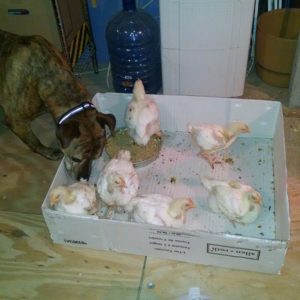
My dogs are pretty used to the chickens, and vice versa, so they don’t bother each other. However, not all dogs are as tolerant of chickens as my dog Babe is.
Fido may be man’s best friend, but a dog can be your chicken’s worst enemy. Even the friendliest family pet might not be able to resist the temptation to chase and even chomp on one of your chickens. The neighborhood dogs might not even intend any harm, but could still kill or seriously injure a chicken just trying to play with it.
Cats
Just like dogs, cats can be a threat to your flock. While most full-grown hens don’t face a lot of danger from a cat, your chicks and young birds are definitely at risk. I have lost a few chicks over the years to the barn cats that live next door.
Rats
At first glance, rats and other rodents don’t seem like a big threat to your chickens. However, from spreading disease to stealing eggs to nibbling on your chickens while they roost, rodents can cause some serious trouble. Rodents can also steal eggs and kill chicks and young birds.
Hawks
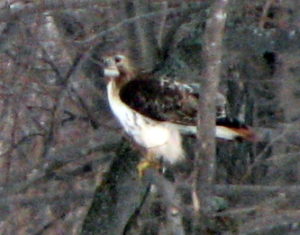
Hawks can and will go after chickens if they are hungry. I’ve had to scare several off when my flock has been free ranging. Roosters can be a good way to protect your flock as they will warn the flock about the hawk so the flock can hide.
Aerial predators open up a whole new set of worries for backyard chicken keepers. The highest fence won’t stop a bird that can just swoop in from above.
Foxes and coyotes
These sneaky predators will keep you and your flock guessing. Just when you think they like to hunt around dawn, they strike at dusk. Then, just when you think the middle of the day seems safe, a chicken goes missing with nothing but a few stray feathers left behind. In my experience, both foxes and coyotes are ambush predators. They like the cover of tall grass and plants to hide them while they sneak up close to your chickens. Then they pounce.
Snakes
Snakes can be a big threat to your flock depending on where you live. If you live where venomous species live, there is always the risk of one killing one of your chickens. Non-venomous snakes can also pose a risk. Not only do some snakes eat eggs, they can also just as easily eat a chick.
Skunks
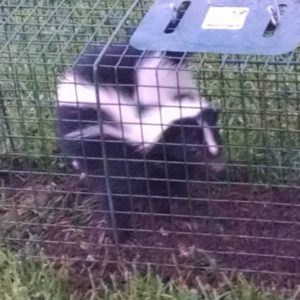
Skunks might not always go after your chickens, but they are definitely a nuisance to have around. Besides the, um, odor, they also steal eggs and dig under fences. And don’t for one second think that a skunk can’t or won’t kill a chicken because they can.
These malodorous fiends will steal eggs and can kill chickens. More likely though that they may raid your feed dishes at night for anything left behind.
Raccoons
The trash panda may look cute, but it’s not a friend to your flock. Raccoons will easily kill a chicken. If you find a dead chicken with the crop and neck ripped out, a raccoon is your most likely culprit. They can also be one of the hardest predators to keep away from your flock. They are smart and they are sneaky.
Protecting your flock from suburban poultry predators
Fencing
A good strong fence (welded wire, NOT chicken wire) goes along way toward keeping your flock safe from a variety of predators. Install fencing at least 6 feet high and for ideal protection, bury the bottom of the fence 6 or more inches into the ground. This will discourage animals from digging under the fence. You can also set the bottom of the fence in concrete to make it more secure.
Roosters
If they are allowed in your area, roosters are a great option for protecting your flock. It’s their job to watch for potential threats and alert the flock.
Motion lights
Motion activated lights around the coop can help deter a variety of nighttime predators. Most, including raccoons, are often scared off by light. There are a variety of options from battery operated to solar-powered ones to fit your needs.
Reflective tape/objects

This reflective “scare tape” can help keep hawks and other aerial predators away from your chicken run.
Reflective objects can help scare off any aerial predators. This can include prismatic bird tape or some people have even had success hanging old CDs around their coop. Every spring, I put new pinwheels along the top of my run fence.
Hiding spots
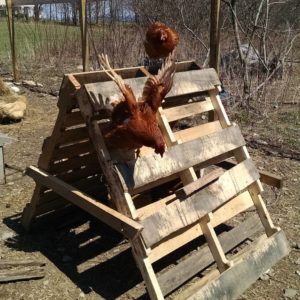
This pallet project provides a safe space to hide in the uncovered part of my run. It also doubles as a jungle gym for my pullets!
Take steps to keep your flocks safe in uncovered run or while free ranging. Provide them places to hide from aerial and other predators. Trees, shrubs, and more provide your flock a safe space to hide if the need arises. I even have a little hideaway made from old pallets in the uncovered part of my run.
A secure coop
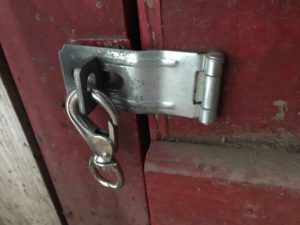
A secure coop is the best way to keep your flock safe, especially at night. But raccoons are pretty smart and crafty, so make sure things are securely locked. My chicken door is secured with both a twisting hasp and a snap lock.
This is the most important element when it comes to protecting your flock from many predators. Cover any windows or openings with strong welded wire nailed in place. No chicken wire! Close up small gaps with expanding foam to keep rodents and reptiles out. Raising the coop up off the ground will keep skunks and other diggers from tunneling in. Finally, get some sturdy locks for the doors. Don’t use a simple hook and eye that a raccoon can easily open. I secure my chicken door with both a twisting hasp and a snap lock to keep raccoons from opening it.
When it comes to suburban poultry predators, the best defense is a good offense. Take steps now to prevent predator incidents and help keep your flock safe.
Traci DeLore grew up around chickens on her family’s farm, but didn’t start keeping her own chickens until she was in her 40s. Her desire to keep chickens came from a desire to have her own fresh eggs from chickens she knew were well cared for and happy. Traci started with six chickens – and then chicken math took over. These days, she has about 60 chickens — and three “rotten” ducks. (I say this because having ducks is like living with toddlers.) Traci also raises and processes her own meat chickens on occasion. Follow her on Instagram.














6 Comments
After several hawk attacks, and one chicken killed, I got the bright idea to glue on hundreds of feathers on my owl decoy. Even added moveable wings that fluttered in the breeze. It looked so real!! I was patting myself on the back for a couple weeks, no hawks! Then I looked out the window one day and a hawk landed RIGHT NEXT to the owl on the fence! So, on to plan B….
Then I happened to see online, http://www.dogdecoy.com and I purchased the dog decoy. It is made to keep geese away, so I thought why not give it a try? So far, so good. No hawk attacks. It moves in the wind to make it look alive.
So, the jury is out, but so far, so good! If this doesn’t work, we are buying “bird netting” to put over the entire chicken yard.
At my farm in Iowa, there is no stopping the hawks, and the Great Horned Owls at dawn, except to keep them in their outdoor pen that I had to cover with chicken wire. That was quite a job as their outdoor pen is very big. And once the corn or beans get a foot tall, the fox will hide in the rows and wait for the chickens to walk by if I have them out, free-ranging. I have a lot of area to mow, and my mower is a loud diesel, so I let them free range while I mow, the critters don’t like to see and hear me.
I had to put a top on their pen even though their fence is 6 feet high. The hawks would sit on it and wait the the chickens to come out of the coup, they even have gone in it and grabbed a girl. The rest, including my really aggressive rooster, were hiding in and under the nesting boxes. It took days before they would even go outside.
My best success has been having a goose. I had one for 2 years then my husband got ‘annoyed’ by it so I gave it away. The following year lost almost all my birds to raccoons. I know because we trapped and killed 6 of them. The following spring, I got another goose and guess what? I trapped 2 more raccoons but have lost no more birds. I recommend this highly to everyone. It’s worth the ‘annoyance’…which are simply the goose’s WARNING SQUACKS!!!
Thanks
What can I use to keep birds of prey away during the daytime hours while my girls are playing in our yard? (a bobble head type of take bird on the roof of the coup or on the fence? but won’t it scare the chickens? reflective tape or CD’s as recommended but in daytime hours)
Will my guinea fowl protect them from birds of prey?
Hi Kelly,
I’ve had hawks go for our chickens a number of times. We tried netting, which helped, but I don’t really want a hawk to get caught in the netting. So we finally landed on ropes strung above the run with streamers, shiny bits (CD’s and tin foil) and flags. They are visually confusing for the hawks and seem to keep our poultry a bit safer which they scratch and bathe.
Guineas are pretty good watch birds. They alarm when hawks and owls are near.
I can also really recommend Gail Damerow’s “What’s Killing My Chickens?” We carry it in the bookstore (link below) and I use my personal copy all the time.
https://store.communitychickens.com/product/what-s-killing-my-chickens